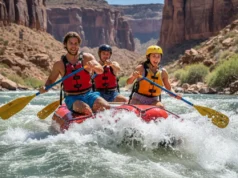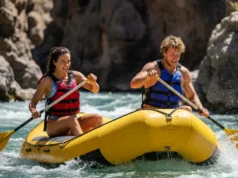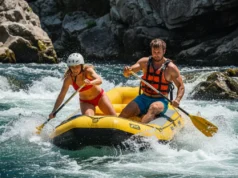In this article
The roar of whitewater ahead is a universal call to adventure for any white water rafting enthusiast. But as you stand on the riverbank, ready to push off into the current, the price tag of a guided trip can feel as complex and intimidating as the rapids themselves. It’s a common eddy for aspiring rafters to get stuck in, asking “How much does this cost?” without a clear map to the answer. This guide is your map. We’re going to demystify those trip costs, moving beyond the sticker price to reveal the intricate ecosystem of safety, expertise, and logistics you’re investing in. We will dissect the rafting trip cost, uncovering operational expenses from guide pay to gear amortization, and analyze the real “return on investment” of a premium trip. By the end, you won’t just know the price benchmarks; you’ll understand what you’re actually paying for, transforming your understanding of cost into a powerful tool for choosing your next great whitewater adventure.
The Spectrum of Rafting Costs: A Top-Level Market Analysis
Before we can understand the why behind the price, we need to establish a baseline for what things cost. In the adventure tourism market, rafting trip costs are anchored to two key variables that every potential guest considers first: the trip duration, and where in the world that water is.
How Do Trip Durations Define the Basic Price Tiers?
The simplest way to categorize rafting trips is by their time commitment, or trip duration. A quick splash and a multi-day rafting expedition are fundamentally different products, and their cost range reflects that. A half-day trip, typically running two to four hours, serves as the perfect introduction to the sport. Costing between $30 and $119 per person, these trips focus on a concentrated, action-packed section of river and rarely include meals, designed to give you a potent dose of adventure in a short window of time on water.
For those seeking a more immersive experience, a full-day trip of five or more hours is the next step up. Ranging from $65 to $189, this trip pricing reflects a longer day, greater trip length in miles, and the standard inclusion of a riverside snack or lunch—a welcome break that becomes a core part of the day’s rhythm. The pinnacle of river travel, however, are the multi-day expeditions. Spanning anywhere from a 3-day river trip to twenty-one days, these are true wilderness journeys. Costs can range from $600 for a weekend trip to over $8,000 for a remote, iconic rafting expedition in a location like the Grand Canyon. Here, the key metric shifts to the average cost per day, which generally falls between $300 and $500.
This price progression isn’t a simple linear increase; it reflects an exponential jump in logistical complexity, a key difference in the guided vs. self-guided debate. A half-day trip is relatively straightforward, covering the on-water experience and a simple vehicle shuttle. A full-day trip adds the complexity of food service. But multi-day river expeditions are in another league. These are all-inclusive operations, covering professional river guides, all meals, all camping equipment, and incredibly complex gear transport. The model shifts from paying for a simple activity to investing in a comprehensive, fully supported wilderness expedition. This is where you begin to see how geography acts as a powerful multiplier, often influenced by factors like the National Park Service commercial use authorizations that govern these pristine areas. Understanding this leap in complexity is the first step in creating a systematic approach to multi-day trip planning.
| Rafting Trip Costs by Duration | |||
|---|---|---|---|
| Trip Duration | Time on Water | Cost Range (per person) | What’s Included |
| Half-Day | 2-4 hours | $30 – $119 | Designed for a short, action-packed experience; rarely includes meals. |
| Full-Day | 5+ hours | $65 – $189 | A longer, more immersive day that typically includes a riverside lunch or snack. |
| Multi-Day | 2 to 21 days | $600 – $8,000+ | A comprehensive, all-inclusive expedition covering guides, meals, camping gear, and transport. |
How Does River Difficulty Exponentially Impact Price?
Just as a calm trail hike and a technical mountain climb have different costs, so do different classes of rivers. The price you pay is a direct reflection of the river difficulty and the risk being managed. Trips on gentle Class I-II rivers are scenic rafting trips with the lowest operational costs. Due to minimal risk and less stringent guide requirements, these are often priced under $60.
The heart of the commercial rafting industry is Class III (Intermediate) water, which serves as the pricing benchmark for a classic whitewater experience. A trip on a river like the South Fork American, with famous rapids on sections like Chili Bar or the Lower Gorge, is a classic Class III run typically costing between ~$99-$159. As you move up to Class IV (Advanced), the price takes a noticeable jump. A California river rafting trip on the nearby Class IV Middle Fork American or Merced River, often meeting in Auburn or Coloma, costs ~$139-$169. This increase reflects the need for more experienced guides and robust safety protocols.
| The Price of Risk | |||
|---|---|---|---|
| River Class | Example River (California) | One-Day Trip Cost (Approx.) | What the Price Reflects |
| Class III (Intermediate) | South Fork American (Chili Bar, Lower Gorge) | $99 – $159 | The benchmark for a classic whitewater experience with manageable risk and standard guide expertise. |
| Class IV (Advanced) | Middle Fork American or Merced River | $139 – $169 | A noticeable jump in price for more powerful rapids, reflecting the need for more experienced guides and robust safety protocols. |
| Class V (Expert) | Cherry Creek / Upper Tuolumne or California Salmon | $425 – $434 | A direct function of professional risk management, including elite-level guides, specialized training, and a low guide-to-guest ratio. |
The most dramatic leap occurs when you enter the realm of commercially-run Class V (Expert) water. Here, the trip pricing for these adrenaline-pumping rapids skyrockets. A one-day trip on a world-renowned run like Cherry Creek / Upper Tuolumne or the California Salmon costs between $425 and $434. This isn’t just about bigger waves; it’s a direct function of professional risk management. A professional outfitter must employ elite-level guides with specialized training, maintain low guide-to-guest ratios, and pay higher insurance premiums. The price difference between a Class III and a Class V trip clearly illustrates that you are paying for professionally managed risk. This relationship between risk and price becomes even clearer when we examine iconic destinations where demand and regulation create a unique economy, all while adhering to standards like the Leave No Trace principles for river corridors. This cost directly corresponds to the hazards and skills outlined by the International Scale of River Difficulty.
Pro-Tip: When comparing trips on advanced (Class IV/V) whitewater, ask the outfitter about their guide-to-guest ratio. A lower ratio (e.g., 1 guide to 4 guests vs. 1 to 6) is a key indicator of a company’s commitment to safety and a more personalized experience on demanding water. It’s a direct investment in your well-being.
Deconstructing the Price Tag: The Anatomy of an Outfitter’s Operational Costs
Now we move from what things cost to why. That ticket price you pay is like the calm surface of a deep river; beneath it lies a powerful current of operational costs that are often invisible. This cost breakdown analysis allows you to shift your perspective from simply buying a “ride” to investing in a professionally curated and managed experience.
What Are the Primary “Behind-the-Scenes” Costs You’re Paying For?
When you buy a rafting trip, you’re paying for much more than just a seat in a boat. The largest portion of your ticket, typically 25-35%, goes to Guide Compensation & Training. This covers wages for the professional river guides and their ongoing training and certifications. Another significant fixed cost is Liability Insurance (10-15%). As a high-risk activity, comprehensive insurance is mandatory, and premiums increase for outfitters running challenging Class IV and V rivers. Closely related is Equipment Amortization (10-15%). A top-tier commercial raft can cost over $9,000 and has a finite lifespan. This category covers these capital assets, plus the replacement cycle for PFDs, helmets, and paddles.
The hidden costs continue with Transportation & Logistics (10-15%), which includes fuel, vehicle maintenance, and the staff time dedicated to running the complex vehicle shuttle from the put-in to the take-out. Outfitters also pay a Government Use and Service Fee (5-10%) to agencies like the NPS, BLM, and USFS. These government fees, covered by permits like the BLM Special Recreation Permits, are passed directly to you. The remaining 15-25% is a catch-all for Food, Admin & Profit. This covers food costs, office staff, marketing, and the outfitter’s net profit margin—typically a modest 5-10%.
The Value Proposition: Analyzing the Return on Your Rafting Investment
With a clear understanding of the cost structure, we can now perform a cost-to-value ratio analysis. Why pay more for a premium trip? The answer lies in the tangible and intangible value factors that a higher price buys—benefits that often correlate directly with a better, safer, and more memorable experience from a professional outfitter like American Whitewater Expeditions or Western River Expeditions.
Beyond the Rapids: What Do You Get From a Premium-Priced Trip?
First, a premium price buys Enhanced Safety & Peace of Mind. Top-tier operators invest heavily in safety. Their guide services exceed minimum standards with long safety records, rigorous guide training, and meticulous emergency protocols. This is supported by superior guide expertise. Guides on premium trips are often career professionals who act as interpreters of the riverine environment, sharing knowledge of geology, ecology, and history that enriches the journey through landscapes marked by pristine waterfalls, towering cliffs, and deep canyon walls that can rise nearly a mile overhead. This is made possible by Lower Guide-to-Guest Ratios.
The value extends to comfort and service. The equipment provided, especially the rafts, is of a higher quality and in better condition. This is especially apparent on a multi-day rafting trip, which might feature spacious tents, thicker sleeping pads, and comfortable camp chairs. A major differentiator is Elevated Cuisine and Service. Premium trips transform a campsite into a riverside bistro. Many also practice strong conservation practices to protect the environments they operate in. Finally, many premium outfitters feature All-Inclusive Pricing. They include items like wetsuits or splash jackets, recognizing them as essential for comfort and safety equipment quality. This avoids “à la carte” fees. The stringent Maine’s requirements for whitewater guides is a great example of the high bar that premium outfitters often exceed. This entire concept of value is central to the four-pillar framework to vet rafting outfitters and choose an operator that aligns with your expectations.
Strategic Budgeting for Your Next River Adventure
Armed with a complete understanding of the cost structure and value proposition, you can now build a comprehensive budget. The ticket price is just the starting point; using sound budget planning strategies for the total cost is key to a stress-free adventure.
How Do You Plan for the Total Cost Beyond the Ticket Price?
The most significant expense beyond the base price is the Guide Gratuity. Tipping is a standard industry custom. You should budget for 10% to 20% of the total trip cost, typically paid in cash at the end. For a $3,000 multi-day trip, this can be an extra $300-$600. The multi-factor tipping matrix can help. Next is Travel and Lodging. You are responsible for getting to the meeting time/location. This can include airfare (e.g., into Las Vegas, NV for a Grand Canyon trip), rental cars, and fuel, as well as pre- and post-trip lodging. Don’t forget Personal Gear & Apparel. While the outfitter provides technical gear, you need non-cotton layers, secure river footwear, sun protection, and for overnight trips, your own sleeping bag. Also, be aware of any minimum age requirements and check the outfitter’s cancellation policies before you book now.
To find the best value, consider seasonal cost trends. Weekend trips are almost always more expensive than weekday trips. Booking in the “shoulder seasons” can offer lower prices. Finally, look for Group Discounts or youth pricing. Nearly all outfitters offer discounts for groups of 10 or more. By combining this knowledge of cost, value, and budgeting, you can confidently enter the booking process, ready to ask the right questions.
Pro-Tip: The single best way to maximize value is to book a mid-week trip during the shoulder season (May/June or September). Demand is lower, prices are often reduced, and you’ll get to experience the river with fewer crowds, often leading to a more intimate and wild experience for a fraction of the peak season cost.
Conclusion
The true cost of a rafting trip is a complex blend of variables dictated by trip duration, location, and river difficulty. A significant portion of your ticket price covers non-negotiable operational costs like government permits, liability insurance, and expert guide compensation. The price difference between a budget and a premium trip reflects quantifiable investments in safety, guide experience, equipment quality, and overall comfort. Ultimately, a complete trip budget must account for ancillary costs, most notably guide gratuities of 10-20% and your own travel and lodging expenses.
Armed with this knowledge, you are no longer just a price-shopper; you are an informed adventurer. You are ready to plan your next trip, weigh the value, and choose an experience that perfectly aligns with your goals. Explore our comprehensive guides to the world’s best rafting destinations to put your new expertise into action.
Frequently Asked Questions about Rafting Trip Costs
Why are Grand Canyon rafting trips so expensive?
Grand Canyon rafting trips are expensive due to a combination of immense global demand, a restrictive National Park Service permitting system that creates scarcity, and extreme logistical complexity in a remote environment. The journey, often starting from the Lee’s Ferry boat ramp, covers many river miles. These factors drive up operational costs for labor, transportation (for both a motorized trip and an oared trip), and regulatory compliance for landmarks like Phantom Ranch.
How much should you tip a river guide?
The accepted industry standard for tipping a river guide is 10% to 20% of the total trip cost. This gratuity is a significant and expected part of a guide’s seasonal income and should be factored into your budget from the start.
What is the cheapest way to go whitewater rafting?
The most affordable option is typically a half-day trip on a popular, accessible regional white water river during a weekday. Rivers like the Ocoee in Tennessee, the Nantahala in North Carolina, or even the Shenandoah and Potomac near Harpers Ferry, West Virginia, offer some of the most budget-friendly guided trips in the country, with prices starting as low as $35-$55.
Are meals and gear included in the price of a rafting trip?
It depends on the trip duration. Half-day trips usually do not include meals, while full-day trips almost always include a riverside lunch, and multi-day trips are all-inclusive with all meals and camping gear provided.
Risk Disclaimer: Whitewater rafting, kayaking, and all related river sports are inherently dangerous activities that can result in serious injury, drowning, or death. The information provided on Rafting Escapes is for educational and informational purposes only. While we strive for accuracy, the information, techniques, and safety advice presented on this website are not a substitute for professional guide services, hands-on swiftwater rescue training, or your own critical judgment. River conditions, including water levels, currents, and hazards like strainers or undercut rocks, change constantly and can differ dramatically from what is described on this site. Never attempt to navigate a river beyond your certified skill level and always wear appropriate safety gear, including a personal flotation device (PFD) and helmet. We strongly advise rafting with a licensed professional guide. By using this website, you agree that you are solely responsible for your own safety. Any reliance you place on our content is strictly at your own risk, and you assume all liability for your actions and decisions on the water. Rafting Escapes and its authors will not be held liable for any injury, damage, or loss sustained in connection with the use of the information herein.
Affiliate Disclosure: We are a participant in the Amazon Services LLC Associates Program, an affiliate advertising program designed to provide a means for us to earn advertising fees by advertising and linking to Amazon.com. As an Amazon Associate, we earn from qualifying purchases. We also participate in other affiliate programs and may receive a commission on products purchased through our links, at no extra cost to you. Additional terms are found in the terms of service.





